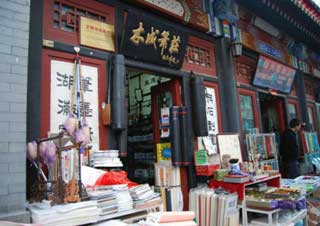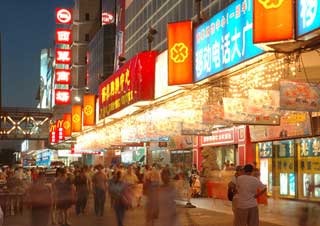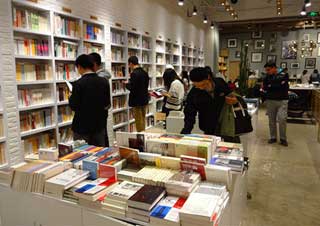- 86-15907880780
- contact@youngchinatravel.com
A tourist couldn’t visit Beijing without bringing back  gifts and souvenirs. Beijing is a paradise for shopping. Traditional crafts have so many kinds, such as cloisonné, jade articles, ivory and lacquer carving wares. Besides, a variety of articles with strong Beijing folklore flavor, such as paper masks, cutting paper objects, sniffing odor pots, and imperial lanterns could be found here. In addition, regional flavor snacks, local products, pearls, jewelry, ornamentals, costumes and silks are easy to be chosen here.
gifts and souvenirs. Beijing is a paradise for shopping. Traditional crafts have so many kinds, such as cloisonné, jade articles, ivory and lacquer carving wares. Besides, a variety of articles with strong Beijing folklore flavor, such as paper masks, cutting paper objects, sniffing odor pots, and imperial lanterns could be found here. In addition, regional flavor snacks, local products, pearls, jewelry, ornamentals, costumes and silks are easy to be chosen here.
The technology includes carving, engraving, inlaying and painting technologies. Which are divided into different kinds of skill, such as: colored lacquer with engraving gold, helix- curve and jade inlay, gold-silver coating and polished lacquer paintings etc.
The cloisonné process begins with the casting of bronze into shapes, to which are then applied enamels of different colours. This art form began during the Yuan Dynasty and was greatly developed during the Jing Tai era(1450-1456)of the Ming Dynasty. The colour of the applied enamel at that time was often sparkling blue, which is why the word for cloisonné appears in Chinese characters as Jing Tai blue.
Cloisonné pieces appear in many forms with a variety of patterns. Some are decorative, while others are utilitarian. Among them are vases, ash trays, pens, miniature animals, jewellery, and dishes. Cloisonné items produced in Beijing are one of those most welcome gifts.
Lacquerware carving is a special craft. Before the carving, a hundred (in some cases up to five hundred) coats of lacquer arc applied to a bronze or wooden body to a thickness of five to eighteen millimetres. After the lacquer has dried in the shade, the piece is carved with landscapes, human figures, flowers, birds, animals, or geometric patterns. The lacquerware carved in Beijing is delicate and precise and often achieves a three-dimensional effect. Historically, there were more than thirty different kinds of lacquerware in Beijing.
Since Ming Dynasty, Beijing became a jade producing place. For example, the Great Jade mountain and sea in Circle City of Beihai Park and Harness Flood by Dayu are seldom seen and famous jade masterpieces in the world. Owing to the hardness of jade to be used by diamond polishing and various instruments, one precious article shows the extraordinary skill of the handcraft masters.
Liaoqi was called in the ancient time liuli , which are glazed utensils or objects, with low melting point, consisting of transparent or milk-like material. Artists create different articles with various skills, such as pull, point, press, print and slide methods.
It is a traditional technology by weaving the colored wool on the cotton median-parallel threads. The carpets are divided into those for lying, stepping and hanging etc.
At the northeastern side of the flyover at Fuxingmen, Beijing, erects the building of Chinese Arts and Crafts Gallery in which lots of precious craftworks are exhibited. You can see the most valuable things in China, when wandering through the gallery for just several hours. Of course they are only for appreciation, and cannot be bought without special permission.
The ideal place for purchase of craft works is the White Peacock Artistic World. It collects articles of all categories of arts and crafts that are offered for sale. The newly-built Beijing Antiques Town has more than 200 stores for ancient jade wares and all traditional handicrafts. Besides, the Arts and Crafts Building at Wangfujing and Youyi Department Store outside Jianguomen are both wonderful places for purchasers.
Panjiayuan Antique Market

The Panjiayuan Folk Culture Market, located in the southern section of East Third Ring Road southwest of Panjiayuan Bridge, is composed of Panjiayuan Collection Market and Beijing Curio City. It is now the largest and most influential centre dealing in artworks and antiques in Asia. The Panjiayuan Collection Market is China's biggest collecting and distributing centre of art and craft works. Panjiayuan has become a name card of Beijing together with Great Wall and Roast Duck. "Climbing the Great Wall, tasting the Roast Duck, and strolling around the Panjiayuan Market" have become three necessary activities for foreign tourists in Beijing tour.
The Panjiayuan Folk Culture Market has become world's largest antique trade centre by dint of traditional trade mode, unique folk style, diversified collections, first-rate marketing facilities and crowded shoppers?" At consists of four operation zones, i.e. craftwork zone, furniture zone, calligraphy & painting zone and curio zone, and with over 3000 stalls altogether, dealing in f ancient-style furniture, four treasures of the study (writing brush, ink stick, ink m slab, paper), ancient books, calligraphies & paintings, agates & jades, porcelains, ancient Chinese and foreign coins, bamboo, wood, ivory and horn carvings, theatrical masks & puppets, Buddhist amulets, national costumes and decorations, mementos of Chinese Cultural Revolution Period (1966-1976) and the like. It ranks first among China's Top 10 Antique Markets.
Liulichang Culture Street
Liulichang Culture Street used to be the place where kilns for pro-ducing glazed tiles were situated in the Yuan and Ming dynasties. In the early Qing Dynasty, business people of antiques opened antique shops on the street. During the Qianlong reign period (1736-1795), Liulichang became a collecting and distributing center of ancient paintings, calligraphy, ancient books, rubbings, and the four treasures of the study (writing brush, ink stick, ink slab and paper). In 1982, Liulichang Culture Street was renovated, and now it has become a street with unique cultural characteristics in Beijing.
Transport: Tourists may take the subway and get off at Hepingmen Station, and then walk 250 meters along South Xinhua Street.
Xiushui Market
Close to the Friendship Store and the embassy area, Xiushui Market is a must place for foreign business people and tourists. As a lane of nearly 300 meters long, it is lined with dozens of stalls, mainly selling clothes, shoes, hats and silk products. Various kinds of commodities with flexible prices can be found in the market.
Transport: Tourists may go to Jianguomen by subway and walk about five minutes.
Qianmen Commercial Street
This district is an old flourishing commercial region early since Ming-Qing Dynasty. In recent years, after renovation, it becomes a pedtrian street (Dazhalan) with distinct characteristics and attractive environment, in which many time honored shops of more than a hundred years old are situated, such as Neiliansheng Shoe Store, Zhangyiyuan Tea Store, Tongrentang Pharmacy, Liubiju Sauce-vegetable shop, Ruifuxiang Cloth Shop etc , which enjoy great popularity among consumers. Besides, some famous commercial centers and new commercial mansions, restaurants and shopping centers have been founded in recent years.
Qianmen Eight Great Xiang
In the Qianmen district, there have existed eight silk-cloth shops with the word of Xiang (luck), which were established in Tongzhi of Qing Dynasty by the Meng family from city Jinan of Shandong province, but up to now only two of them remain. They are Ruifuxiang and Qianxiangyi the name of which changed to Beijing Silk-Satin Shop.
Qianmen Eight Great Xiang In the Qianmen district, there have existed eight silk-cloth shops with the word of Xiang (luck), which were established in Tongzhi of Qing Dynasty by the Meng family from city Jinan of Shandong province, but up to now only two of them remain. They are Ruifuxiang and Qianxiangyi the name of which changed to Beijing Silk-Satin Shop.
Qianmen Street - Famous Pedestrian Street
Bearing a history of over 570 years, Qianmen Street is located at the central axis of Beijing city and in front of Archery Tower of Zhengyangmen. As a famous pedestrian street, it owns many time-honored local brands, like Quanjude Roast Duck, Duyichi Restaurant, and Yitiaolong Mutton Store.
Wangfujing Street
Located on the northern side of the East Chang'an Avenue, Wangfujing Street has a history of over 100 years. Along the 1,000-meter-long street, there are a large number of shops. The Sun Dong'an Plaza, which comes first on the list of the large shopping centers in Beijing, covers a business area of 100,000 square meters, and sells nearly 200,000 kinds of commodities. The Shidu Emporium, which is not far away from the Sun Dong'an Plaza, has a business area of 18,000 square meters and sells various famous-brand commodities.
Xidan Commercial Street

Xidan Commercial Street, situated at the north side of West Chang’an Boulevard is one of the largest commercial districts in Beijing, with strong commercial atomosphere. There are 200,000 customers per day. Many shopping centers gather here, such as Xidan Department Store, Xidan Shopping Center, Zhongyou Department Store, Xidan CVIK Plaza (Saite), Huawei Mall, Dayue City, all of which is a great combination of shopping, food and entertainment. In addition, hundreds individual vendors are gathered in a market named Great National World. Fashion Science-Technology Plaza is mainly engaged in the trade of modern telecommunication products. Beijing Book Building at Xidan attracting book lovers, Hengdeli watch & clock shop and some other Time-honored shops and many special costume shops are located in this district. Newly built Xida Cultural Square, located at the north-east comer, is an open architecture having the functions of leisure, meeting, display and propaganda. Situated at the south-east comer, the Meimei Commercial center is the largest building in this district, which is opposite to the newly built Xidan Grand Hotel, presenting a splendid sight. Xidan commercial district is becoming a international, domestic leading and multi-functional area.
The large scale commercial malls are the concentration sites of fashionable life of Beijing inhabitants, where the charm and splendor of the city displayed thoroughly, and where the new vigor and happiness pour into people’s daily life.

Beijing Book Building
It is situated in the Xidan prosperous commercial district with the area about 10 thousand square meters, In terms of scale; it is one of the largest bookstores throughout the country. The abundant books attract so many book amateurs, provided with convenient services, such as registration for absent books and mail-order. In addition, various kinds of activities, for example, a signing-promotion and issuing ceremony are often held, these make the book mall very prosperous.
Wangfujing Xinhua Bookstore
The new building of this bookstore is situated at the south end of Wangfujing Street close to Oriental Plaza and many government institutions with a very good geo-graphical location. The design of the building gives you the impression of modesty and beauty, practicability and cultural taste, trying to create a shopping environment with warmhearted, graceful and comfortable atmosphere. The store is composed of 8 floors ( 2 underground) with the total architecture area of 17525 square meter, expanded to three times it’s the former. From the 1st to the 5th floor, various kinds of books, audio and video products and electronic publications are on sale, and at the 6th floor different activities of cultural exchange could be held.
Sanlian Taofen Bookstore
Sanlian Taofen Bookstore of Beijing has its geographic superiority neighboring to the China Art Museum. For many years, it has been popular with scholars and book amateurs for carrying forward the traditional civilization.
Mr. Zou Taofen founded Life-Reading- New knowledge United bookshop in 1930. Up to now it mainly involves in the fields of social science and humanities, and the customers are mainly students and a group of old readers. Signature ceremonies, seminars and exhibitions are often held.
Large shopping centers are good place where you should go if you want to buy brand-name and high quality stuff. But it is more fun to visit the Xiushui Market or Hongqiao Market, where tourists can find all kinds of souvenirs and Chinese style costumes and bargain for a satisfactory price.
The shops in Beijing are open from 08:30 to 21:00 every day. Most large shopping centers and designated tourist shops can convert foreign currencies into Renminbi. You can bargain at street stalls and privately owned shops, but not at the large plaza.